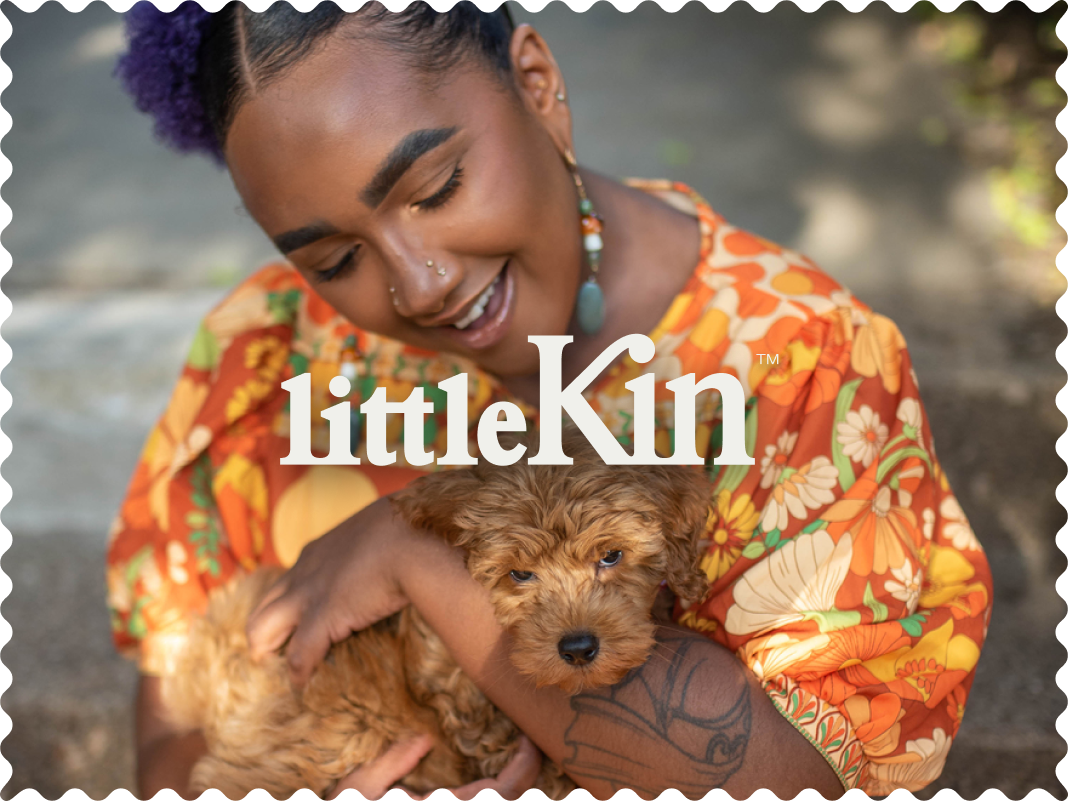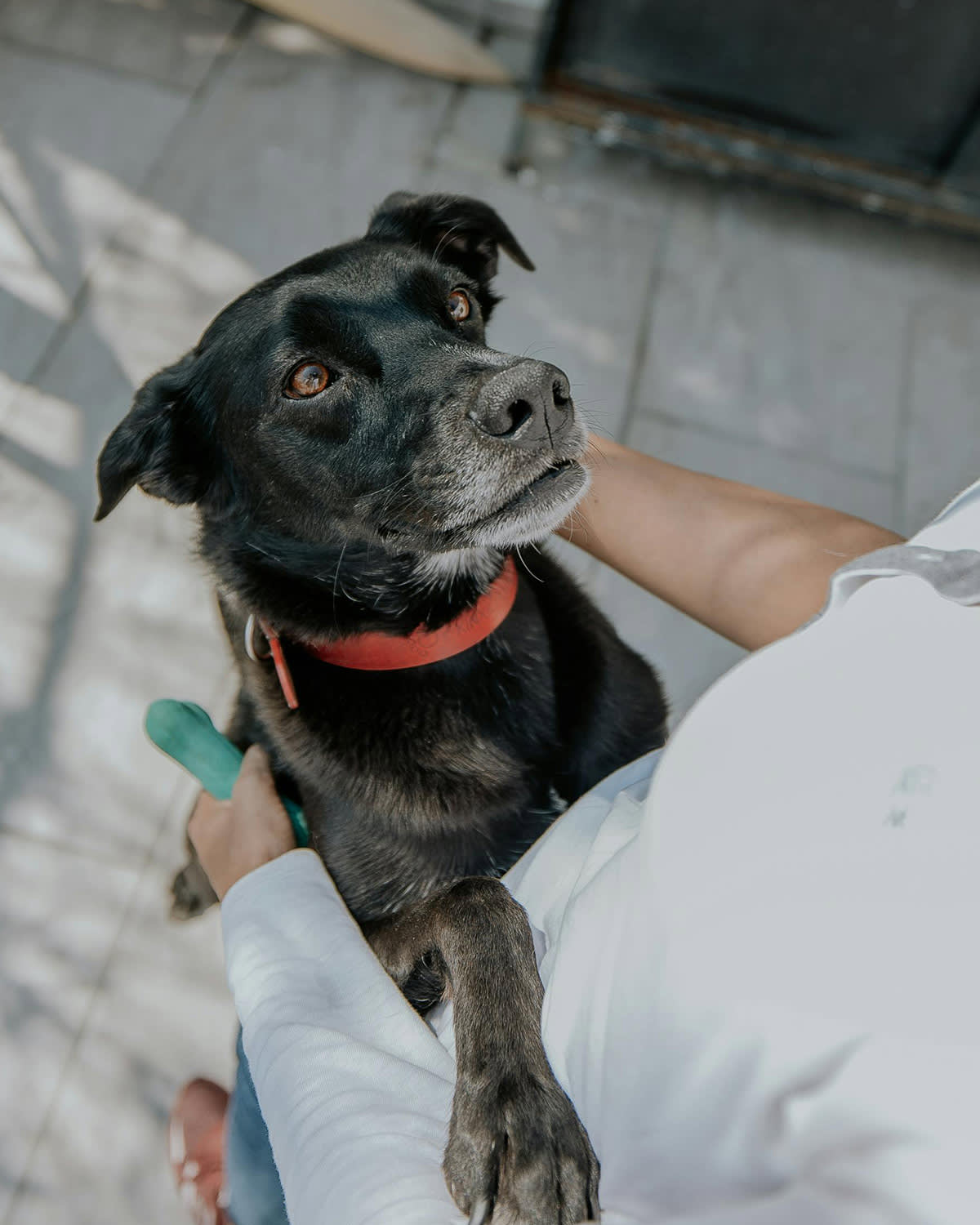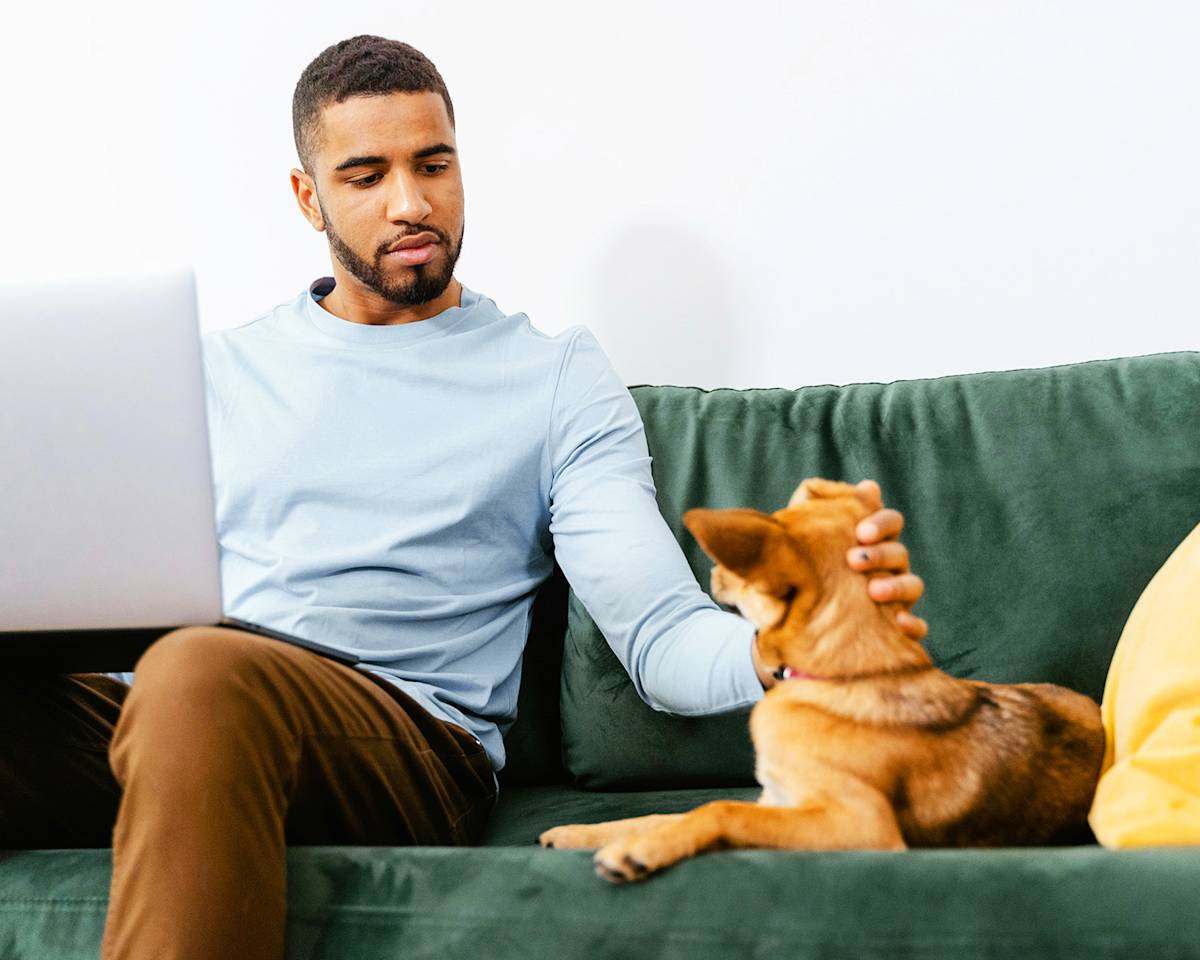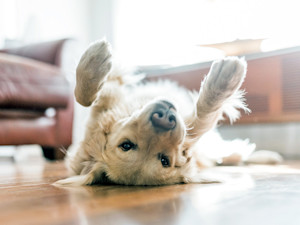Why Your Dog’s Eye Contact Isn’t Always a Good Thing
Hypervigilance isn’t the same as affection

Share Article
We all love when our dogs look at us, making eye contact with their beautiful soulful eyes. Prolonged eye contact is linked to love because it can release the love/hug hormone oxytocin, which helps to foster bonding. Many pet parents perceive attention-requesting behaviours, such as eye contact, pawing or their dog following them around the house, as signs of deep affection. But what if some of these adorable behaviours actually signal something else – something rooted in stress rather than love?
Just like humans, dogs have a complex nervous system that governs how they respond to their environment. When that system becomes dysregulate certain behaviours – even those that appear fairly straightforward – can actually be coping mechanisms for anxiety. Understanding your dog’s body language can help you spot signs of distress early and support their emotional wellbeing.
How your dog’s nervous system affects behaviour
A dog’s behaviour isn’t just attributed to training or temperament, it’s a reflection of their canine nervous system. This system governs how your dog reacts to stimuli, regulates stress and returns to a state of calm after an exciting or fearful situation.
When a dog feels safe, their nervous system operates in balance. They can rest, play, eat and engage socially with ease. But when stress hormones like cortisol and adrenaline take over, it can lead to a dog who is more hypervigilant when out in the world. You may see that your dog regularly displays one of the four commonly recognised responses to stimulus: fight, flight, freeze or fawn.
How much do you spend on your pet per year?
Fight: growling, barking or lunging – this can be written off simply as aggression but more often this response is rooted in fear.
Flight: avoidance, hiding or running away from triggers – when a dog doesn’t have this option when on the lead, they will sometimes escalate to a ‘fight’ response even if this wouldn’t be their usual choice if they had the freedom to move.
Freeze: shutting down, refusing to move or appearing ‘frozen’ – this can be especially difficult for other dogs to experience, as they will be unable to read what your dog is going to do next.
Fawn: appeasing behaviours like licking, rolling over, spinning on the lead – also known as flirt or ‘fiddle about’ – are often misread as a dog being silly or poorly trained, when they are actually trying to reduce the chance of conflict occurring.
When a dog is met with triggering situations too frequently, they can become dysregulated, whereby their nervous system struggles to reset. This state of hypervigilance in dogs can mean they no longer feel safe and relaxed, even in safe environments. They might appear clingy, restless or unable to settle.
Rescue dogs are particularly prone to dog dysregulation and feelings of anxiety. Many have unfortunately experienced trauma, neglect or inconsistent care, which wires their nervous system to remain on high alert. It can turn into a vicious cycle: when a dog feels anxious, they become more hypervigilant to their surroundings. Everyday triggers, like people, other dogs, traffic or noises, stand out more sharply, leading to stronger reactions. These intense responses then release more stress hormones, continuing the cycle of dysregulation.
Recognising the signs of nervous system imbalance is key. It’s important to try and move away from labelling your dog’s behaviour as ‘bad’, ‘reactive’, etc and instead focus on understanding what your dog’s body is trying to communicate – and helping them find safety again.
When eye contact signals stress
While it is lovely to enjoy a deep gaze from our dogs, it’s important to understand that sometimes this might be eye-contact anxiety. The difference between affection and stress lies in how your dog looks at you, rather than if they do.
Soft eye contact, including blinking, relaxed facial muscles and a loose body, signals connection and trust. In contrast, a hard stare, dilated pupils or unblinking eyes can mean tension or fear. While connection on walks is something we all strive for, some dogs may ‘check in’ with their humans excessively, glancing up repeatedly to seek confirmation that they’re safe. This constant monitoring may look sweet – even be something you celebrate as your dog being ‘well trained’ – but it may point to a form of hypervigilance, not devotion.
If your dog is exhibiting a stress response, rather than affection you may see them:
hold their breath or pant
have stiff body posture
display wide or ‘whale’ eyes
struggle to relax even in calm environments
excessively bark
It’s important to be able to tell the difference between your dog being truly calm or seeking reassurance because they feel unsafe. By noticing subtle body language cues, such as tension around the eyes, stiffness in the body, or an inability to break gaze, you can notice when attention-seeking is actually anxiety in disguise.
Attention-seeking behaviours that may signal distress
While affection and attention are wonderful parts of the dog-human bond, certain anxious dog behaviours can mask nervous system imbalance.
Excessive licking
Licking is a natural, soothing action for dogs – it releases endorphins and can help them feel more relaxed. However, excessive licking in dogs can become compulsive. You might notice your dog licking their paws, the sofa or even your hands repeatedly.
Compulsive licking can indicate stress or boredom – a dog may lick themselves to cope with anxiety or even pain. If your dog suddenly starts licking a lot or you see hair loss, redness or sores, then it’s worth a visit to your vet.
Constant pawing
Just like a dog uses a short bark to get attention, they might also use their paws. While a gentle paw resting on your leg might be cute, if your dog paws persistently, it might be a sign of anxious pawing, not playfulness.
If your dog can’t settle unless you’re stroking them or they keep pawing at you for reassurance, they may be struggling to relax or self-soothe. True relaxation comes from feeling safe – being able to sleep and rest in a relaxed manner – not constantly seeking interaction.
Following you everywhere
You may have heard of the term ‘velcro dog’ – a dog who follows you around, unable to cope with your absence. While this might feel flattering, it can be a sign of separation anxiety or an inability to self-settle.
Dogs with anxious attachment struggle to rest unless they’re in physical contact with their person. You might not be able to even go to the bathroom without them whining at the door, or they may panic when left alone. While closeness is a huge part of bonding between dogs and their humans, extreme dependency points to dysregulation, not devotion.
Excessive vocalisation
While a dog barking, whining or howling for attention can be painful to live with – it’s not a ‘bad’ behaviour, it’s much more likely to be a sign of overwhelm. Barking is a form of helpful dog communication, but when constant it can be a sign of nervous system overload. Anxious dogs often vocalise because they can’t regulate internally; they aren’t getting enough sleep/rest; and they need reassurance to feel safe.
If your dog’s vocalisation increases with stress or change, then it’s worth reaching out to your vet or a qualified positive reinforcement behaviourist for support.
The rescue dog connection
Experiences of neglect, abandonment or inconsistent care can leave lasting effects on how a rescue dog processes safety and connection.
A nervous rescue dog may display constant attention-seeking behaviours – pawing, following, licking – not necessarily out of affection, but perhaps because they’re scared of history repeating. These behaviours are coping strategies learned during previous periods of uncertainty.
Understanding rescue dog anxiety means recognising that your dog isn’t being ‘needy‘ – they’re trying to feel secure in a world that hasn’t always been kind. Over time, with gentle consistency, you can help them shift from anxious attachment to secure attachment – where they no longer rely on your presence to feel calm and relaxed.
Supporting your dog’s nervous system
Recognising dysregulation is just the first step in this journey. True progress happens when we’re able to help anxious dogs to feel calm and safe in their own bodies again.
1. Consult a qualified positive behaviourist
A certified professional who specialises in dog behaviour training can assess your dog’s triggers and design a tailored plan. Look for trainers or behaviourists who use positive reinforcement, not punishment – as reward-based methods can build confidence and trust.
2. Gradual desensitisation
Desensitisation is the process of gently exposing your dog to potential triggers or stressors, slowly, with space, and pairing them with positive experiences. For example, you might start far away from other dogs, pairing it with food scatters or playtime. Over repetitions, they can start to link the sight of dogs at that distance with something positive happening. This is only the beginning of the process and it’s important to seek guidance from a behaviourist as to how best to progress.
3. Create a calm environment
Small changes at home can massively reduce overstimulation. Allow natural daylight while masking visual stimulus by using temporary frosting on your windows. Combine this with soft gentle music or white/brown noise to create a buffer between external sounds and the quiet of indoors. Predictable routines can also support somatic healing for dogs. Regular rest is vital for anxious dogs – offer a calm, quiet space to rest in.
4. Enrichment and movement
Enrich your dog’s life through calm walking experiences – such as sniffy walks – or with the mental and physical outlets that puzzle feeders or gentle play provide. These help release frustrated energy and encourage healthy dopamine production, which supports regulation.
5. Seek professional help if needed
If your dog’s stress responses are intense, escalating or have suddenly appeared, start by speaking to your vet and getting a full health check. In some cases, medication or natural remedies combined with behaviour therapy can help stabilise the nervous system, making learning and healing possible.
Your dog’s attention may not always be what it seems. Those longing stares, constant paw taps or shadow-like following might not be love alone – they could be signals of underlying stress.
Recognising these signs isn’t about judgment, it’s about compassion. When we view behaviour through the lens of the body and nervous system, we stop seeing ‘bad habits’ and start seeing emotional communication.

Caroline Wilkinson
Caroline Wilkinson is a Certified Animal Behaviourist. As the Founder of digital pet coaching service Barket Place, Caroline has a passion for improving connections between human and hound, with a focus on relationships and reduction of stress for canines living in a human world.
Related articles
![a nervous dog sits on a sofa]()
Bringing Home A Very Nervous Rescue Dog – A Guide For Anxious Parents
At so many points in those first hours, weeks, months, I screamed, internally: what have we done?
![dogs running with a football]()
5 Types of Enrichment Every Dog Needs
A well-enriched dog is a happy dog – and who wouldn’t want that?
![Corgi sitting in the sun indoors]()
Does the ‘Thank You Theory’ Actually Work for Dogs?
Can thanking your dog for barking stop them barking?
![Cute Golden Retriever rolling on the floor at home.]()
Why Is My Dog Obsessed With Rolling Around on the Floor?
It might look a bit wild, but they obviously don’t care
![]()
Are Dog Licks Really Kisses? The Truth Behind Your Pup’s Slobbery Affection
Wait, have we been getting it wrong this whole time?!







